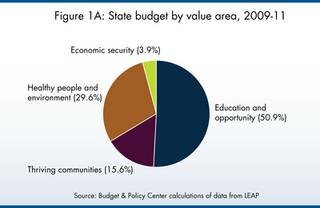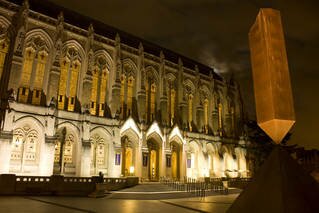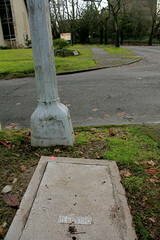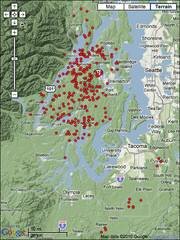"I hate my budget," was the literal money quote from Governor Gregoire, who went on to add, "in some places, I don't even think it's moral."
For the non-budget wonks among us, it's hard to square cutting $4.6 billion out of the 2011-13 two-year budget, so that it still totals a staggering $32.4 billion, with the scorched earth that's being reported: per the Seattle Times, say goodbye to the State Arts Commission and Tourism Office, the Basic Health Plan (an additional 66,000 without health insurance), the Disability Lifeline, state parks funding, and programs for gifted children and juvenile offenders. Here's an itemized list.
(Last Friday, the governor went on to suggest $1.1 billion in cuts from this biennial budget, starting early axe-work on the Basic Health Plan and Disability Lifeline, plus the Children's Health Program, state food stamp assistance, and education funding that supports poorer schools and smaller class sizes.)
 Washington Budget & Policy Center
Washington Budget & Policy Center
So what are we spending $32.4 billion on, exactly? That's the question I asked the Washington State Budget & Policy Center's Remy Trupin the day the state announced a $5.7 billion deficit. You might be surprised to learn that the state's prime directive, as it were, is to fund education. Over half of the state's budget goes to schools ($13.6 billion in 2007-09), higher education ($2.2 billion), and job training ($1.4 billion).
Because education is the state's top priority, that means that health and social services, environmental protection, and things like worker childcare assistance get cut first. But what sounds like a "reasonable" downsizing of the total budget, say six percent, is actually being repeatedly carved out of a much more limited area. Depending on how you slice it, you could be talking about cuts of 25 to 30 percent from budget sectors, and that's when whole programs suddenly go missing....
 Local convicted felon Amanda Knox, currently serving time in Italy for the murder and sexual assault of Meredith Kercher, won a small victory over the weekend when appeal Judge Claudio Pratillo Hellman ordered a review of DNA evidence used at Knox's trial. Two independent experts from Rome's Sapienza University will make new analysis of DNA traces found on the murder weapon and the clasp of the victim's bra.
Local convicted felon Amanda Knox, currently serving time in Italy for the murder and sexual assault of Meredith Kercher, won a small victory over the weekend when appeal Judge Claudio Pratillo Hellman ordered a review of DNA evidence used at Knox's trial. Two independent experts from Rome's Sapienza University will make new analysis of DNA traces found on the murder weapon and the clasp of the victim's bra.
If it's not possible to analyze the DNA, then the investigators will review the analyses that were previously carried out to assess their reliability. Commentators have repeatedly criticized the initial analyses; the bra clasp was not retrieved until three months after the murder, and Knox's defense team claimed that the evidence could have been contaminated.
The review will take at least thirty days, and will begin after the appeal trial's next session, on January 15th. New witnesses are also being heard next month, to refute testimony from Antonio Curatolo, a homeless man who had previously testified that he saw Knox and her ex-boyfriend, Raffaele Sollecito, near the two girls' apartment house on the night of the murder. Knox's appeal is expected to last well into the spring.
 Photo courtesy Slightlynorth of The SunBreak Flickr pool
Photo courtesy Slightlynorth of The SunBreak Flickr pool
- Ballardite goes for win #4 on Jeopardy (My Ballard)
- Kimball crossing guard a jazz and race-relations pioneer (Beacon Hill Blog)
- Elliot Bay Plaza Sold for $54.25 Million (belltownpeople)
- 2 video views of the SPD shooting death of a Capitol Hill homeless regular (Capitol Hill Seattle)
- Pedestrian deaths disproportionately high in Central District (Central District News)
- Local Ferry Service Connects Eastlake to South Lake Union's FarmBoat (Eastlake Ave)
- The Stone Way Pit May Finally Be Turned Into…Something (Fremont Universe)
- Seattle Farm Coop seeks new warehouse (Blogging Georgetown)
- Senator Ed Murray to receive social justice award for improving the lives of LGBT families (My Green Lake)
- Breakdown of Farmers Market costs (Magnolia Voice)
- Read more about proposed Thornton Creek project (Maple Leaf Life)
- City updates multi-family code to allow for more variety in housing (PhinneyWood)
- Seattle Center to move ahead with Chihuly ‘glass house’ plans, KEXP studio and kids playground (Queen Anne View)
- SPD’s South Precinct Gets Fourth Commander in Four Years (Rainier Valley Post)
- The Seattle Times looks at Candy Cane Lane, past and present (Ravenna Blog)
- No permits? No problem for ‘Jiggles’ strip club (Roosiehood)
- Setting the Record Straight on the Columbia City Cinema (Southend Seattle)
- The Cold-Season Diet: Foods that strengthen your immune system (South Seattle Beacon)
- Public Art Coming to Mercer Corridor Project (The Southlake)
- Student robbed at gunpoint (U District Daily)
- Learn how Trophy makes those festive cupcakes (My Wallingford)
- Women of Wallingford (Wallyhood)
- Sewage spill cleaned up at Meadowbrook Pond (Wedgwood View)
- Newest moves in the court fight over ‘The Hole’ (West Seattle Blog)
- White Center in the TV spotlight on KING 5 – twice (White Center Now)...
 Our Flickr pool's Great Beyond gives us "Broken Obelisk at night"
Our Flickr pool's Great Beyond gives us "Broken Obelisk at night"
Ladies and gentlemen, we are taking on water, and in order to survive, some passengers need to be thrown overboard. The good news is that first class and corporate passengers are exempt. Those passengers are welcome to visit our new and improved buffet and to enjoy dancing well into the night.
This announcement also bears a striking resemblance to the weak-kneed announcement regarding the tax "deal" issued this week by the president, now living as a hostage in the White House to cynicism and greed. Just like the middle and lower classes of America.
Here at the University of Washington, this announcement was both expected and anticipated. We've been watching the water rise for a few years now. What this dispatch addresses are the various reactions across campus to the announcement.
- A dean, in an effort to sooth anxiety, sent out an email that said we should go into the holiday break in denial and just enjoy ourselves.
- The interim president, in an article in the Tacoma News Tribune this week, naively insisted that the necessity to accept "alternative funding" (read: corporatization/privatization) would never change the identity and mission of the UW.
- The faculty senate continues to meet, consternate, debate, proclaim, and declare in the cold ocean of irrelevance, since the idea of shared governance at UW is nothing more than a condescending platitude.
- Units and departments frantically rearrange deck chairs, even as the deck chairs themselves are becoming scarce.
- Students who face double digit increases in tuition, larger classes and reduced course offerings continue to Facebook and YouTube their lives away in blissful apathy, gently rocked by the waves of inevitability....
 Earlier this week, I posted about the growing concern that Colony Collapse Disorder may be driven in part by bees' exposure to clothianidin. Clothianidin is part of a class of systemic pesticides known as neonicotinoids, and they have been used widely across U.S. agriculture since the early to mid-1990s. "Systemic" refers to the fact that the pesticide pervades the plant it's applied to entirely, and so any troublesome insect that takes a bite of any part, from root to leaf, will be poisoned.
Earlier this week, I posted about the growing concern that Colony Collapse Disorder may be driven in part by bees' exposure to clothianidin. Clothianidin is part of a class of systemic pesticides known as neonicotinoids, and they have been used widely across U.S. agriculture since the early to mid-1990s. "Systemic" refers to the fact that the pesticide pervades the plant it's applied to entirely, and so any troublesome insect that takes a bite of any part, from root to leaf, will be poisoned.
When bees began dying off in large numbers in Europe, the precautionary principle was employed and neonicotinoid use was restricted or banned. (With interesting bee-bounceback results.) In the U.S., where the EPA professes to have no conclusive reason to act, beekeepers have been left to enforce their own boycott.
A SunBreak reader alerted me to the work of Dutch toxicologist Henk Tennekes (not the climate change impact skeptic), and his research that concludes honey bees and birds can scarcely help being affected by neonicotinoids. "Improper" use of a pesticide is one thing, but his 72-page, heavily footnoted scientific treatise, A Disaster in the Making, demonstrates that this class of pesticides is unsafe in any hands.
"It is a serious ecological report rather than a book for general readers," warns the website, but a serious ecological report is exactly what is required. Tennekes explains in this podcast that neonicotinoids are persistent in the environment in two ways: first, they can be active for months in plants they're applied to, but more importantly, their neurological effects (a dérangement de tout les bee sens) may be irreversible.
Neonicotinoid insecticides act by causing virtually irreversible blockage of postsynaptic nicotinergic acetylcholine receptors (nAChRs) in the central nervous system of insects. The damage is cumulative, and with every exposure more receptors are blocked. In fact, there may not be a safe level of exposure....
(more)
Help us, HAL 9000, you're our only hope
It's ironic that computers run on binary code, because it's us humans who tend to see things as either ones or zeroes. Deciding a moral issue? Pick right or wrong. A political one? Pick Democrat or Republican. An athletic one? Pick win or loss.
Those who want to skitter between two absolutes usually find themselves traveling a road bumpier than Madison St. after a Pineapple Express. Recently, in morality, Jack Kevorkian. Lately, in politics, Barack Obama. And now, in basketball, the University of Washington Huskies.
The humans who cast votes in the Associated Press national basketball poll look at the Huskies and see they've lost three, won six. They therefore do not consider Washington one of the top 25 teams in the country.
But computers see shades of gray. They note that the three teams who've beaten the Huskies are among the nation's best. That those three losses were by a combined 13 points. And that, in their six wins, the Huskies have beaten their opponents by an average of 33 points.
So the two best-respected computer polls make a far different assessment than humans do. Ken Pomeroy's computer rankings put Washington 7th in the country. Jeff Sagarin's USA Today computer ranks the Dawgs 5th (look in the "predictor" column, which accounts for margin of victory).
Of course it's not "computers" that make these rankings, it's people who have programmed the computers. But they do so precisely to banish the indefensible preferences of the human mind from the multi-million-dollar business of prognosticating basketball games....
 The Capitol Hill streetlight/shock device (Photo: CHS)
The Capitol Hill streetlight/shock device (Photo: CHS)
"We discovered that the original installation in 2006 did not include proper grounding of the four lights," said superintendent Jorge Carrasco. "We want the public to be assured that this was an isolated incident."
It was true that, so far as anyone knew, this was the first dog to be killed by streetlight electrocution. But...City Light couldn't really assure anyone, in the actual sense of the word, that there was no further danger because they needed to inspect other streetlights first.
Once they did, a troubling trend emerged. They found another streetlight "leaking" unsafe levels of electricity in High Point. That's not the troubling part per se; that would come when the Carrasco, the "city's highest-paid executive" called the Queen Anne and High Point problems "two isolated incidents."
As CHS reported, City Light soon found three more dangerous light poles discharging electricity--60 to 105 volts. Perhaps more upsettingly, City Light didn't actually find these poles--a contractor did, who took it upon himself to go check on what he estimated would be trouble spots due to aging infrastructure. Two of the poles were 30 to 40 years old, and the third was even older.
Meanwhile, City Light had inspected some 270 light poles without finding any problems in "all of the streetlights at the High Point Development (170) and all of the streetlights at the GreenBridge Development (which actually is in King County, but a part of our service territory - there are 100)."
On Wednesday, a sixth pole was found in Greenwood, discharging "120 volts, enough to kill," reported the Seattlepi.com. So far from being an "isolated incident," streetlights that could electrocute you have been found in Queen Anne, Greenwood, Capitol Hill, Central District, and First Hill. ...
 Of course, the problem could also be the model Pacific Place shopper (pictured) won't fit beneath the low ceilings of a parking garage.
Of course, the problem could also be the model Pacific Place shopper (pictured) won't fit beneath the low ceilings of a parking garage.
I've been using Occam's Razor a lot lately--if I could, I'd shave with it and save a ton of money--so I wonder if a consultant is needed. The thing is, the parking garage worked like a charm for the first eight to ten years of its existence. Even though it was priced below market rate, at $2 per hour, it made up enough in volume (it parks 1,200) to pay for its debt and operations.
It's just that more recently, between 2004 and 2009, use has fallen almost 18 percent, says the Times' Emily Heffter. In 2008, it failed to make enough money to pay for itself. (By city ordinance, it's forbidden to make a profit or build up substantial cash reserves.) In tandem with use falling, the parking rate there has increased to $5 per hour.
It's as if, in a microeconomic sense, there's some indefinable but real-world relationship between the cost of parking and the number of people willing to park there--while at the same time, there's the macroeconomic effect of a major economic downturn having taken place.
To rejigger an old expression, "If it wasn't broke before, undo whatever you did to fix it." In this case, that would seem to indicate rolling back prices. (This doesn't mean you should lower on-street metered parking rates; they are being used so much they're never open, which indicates that most people find them a good deal, comparatively.)...
 Bloomberg Businessweek has assembled one of those link-bait "Best Blank to Blank in the U.S." lists ("America's Best, Affordable Places to Raise Kids"), which are like...not crack, what's something more credible...um...like bacon cheeseburgers to us, so here you are. As it turns out, the kid-friendliest di tutti citta in the state may be, for our local readers, a shocker.
Bloomberg Businessweek has assembled one of those link-bait "Best Blank to Blank in the U.S." lists ("America's Best, Affordable Places to Raise Kids"), which are like...not crack, what's something more credible...um...like bacon cheeseburgers to us, so here you are. As it turns out, the kid-friendliest di tutti citta in the state may be, for our local readers, a shocker.
The Best Place to Raise Your Kids in Washington state is...Pullman. Ready for the next jab? The runner-up is West Richland. Now, this may not be as remarkable a west-side shut-out as it appears, as to judge from the blurb, the key criteria were "bordering Idaho," "wheat fields," "geographic marvels," and "high WASL scores." Also, "Pullman is a seat of learning and home to Washington State University."
Obviously not every city can be home to WSU, and there's no arguing the wheat field gap with our eastern neighbors. Bloomberg didn't even mention the Giant Palouse earthworm, which we have absolutely no answer to, and which you have to know is like...oh god, not crack again...uh...well, it's like any giant weird creature to kids.
In all seriousness, Bloomberg says they wanted to focus on smaller towns and cities, and not large, urban areas. I suppose that's nice and Norman Rockwell, but really? It seems a substantial assumption that kids are better off getting run over by a wheat combine than the express bus to downtown. Have you ever looked at the kinds of accidents farm kids are prone to? It's gruesome, and nearly always involves losing an arm to a machine. Still, it's a gut-check to realize that Eastern Washington still came out in front on the following:...
 O'Dea's student section: Note "ref guy," "condom hat guy," and "golf breeches guy."
O'Dea's student section: Note "ref guy," "condom hat guy," and "golf breeches guy."
So you have O'Dea. An all-boys Catholic high school. Their student section stands, chants and moves in unison. Their basketball team plays an intricate, switching style of defense. Their coach, former Sonic Al Hairston, paces the sideline poker-faced, arms crossed.
Then you have Rainier Beach. A co-ed public high school. Their cheerleaders didn't manage to show up until halftime. Their basketball team plays a playground-style, drive-and-dish offense. Their coach, Mike Bethea, shouts and gestures wildly at his players all game.
O'Dea, the 2nd-ranked 3A boys basketball team in the state: Order.
Rainier Beach, ranked 1st: Chaos.
Who wins? Tuesday night, Chaos triumphed, in a fittingly chaotic finish.
Chaos smacked Order at first. Beach sped to a 24-12 first quarter lead, beginning the scoring with a thunderous Michael Middlebrooks dunk. Later, Hikeem Stewart, who'll play for the University of Washington, turned chaos into an art form. Stewart drove from the right wing down the baseline, collapsing the O'Dea defense around him, then passed to an open teammate on the left wing. But Stewart wasn't done. He followed the path of his pass, ending up along the baseline opposite where he started. The teammate he'd just passed to fed it back to Stewart, who set himself, received the pass, and swished in a three-pointer. He had four threes in the first half....
 Examples of Sunergy Systems residential installations
Examples of Sunergy Systems residential installations
NW SEED hopes to roll out the Solarize program to two more neighborhoods in 2011, so let the online lobbying begin.
Solarize Queen Anne includes a registration process to determine which Queen Anne residents are interested in learning about solar power, workshops, and free site assessment from Ballard's Sunergy Systems to see if solar power can light up your life effectively. Best case, you have a roof with tons of southern exposure, and that can handle a solar installation on top.
What makes Solarize Queen Anne different than simply asking Sunergy Systems to install a few panels on your roof is that they're leveraging community interest to make discounted bulk buys of materials. So in addition to a Federal Residential Solar Tax Credit, a Washington State Renewable Energy Production Incentive, and a Washington State sales tax exemption, participants will see bulk purchase savings.
You may have questions about solar energy in Seattle. It's a little counterintuitive, but keep in mind that while there was actual sunshine this afternoon, in mid-December, where you might really send the meter spinning backwards (not that they do, anymore, it's just an expression) is during our long summer days. And if you're among the 500 people who have been without power all day, you might really appreciate the benefits to having your own power source.
First, how does "Environmental Dereliction Agency" sound? I feel like "Protection" is really giving people the wrong idea about the actual results of EPA regulation.
Second, I should warn you that if you continue reading, you'll be begin to wonder how we're all not dead yet. Thanks to Grist's Tom Philpott, I was just alerted to the leaked EPA documents that show the agency's fumbling approval of a broadly used, very toxic pesticide.
It's been on the market since 2003--bringing in $262 million in sales in 2009 alone says Philpott--but a key study on the pesticide's safety was not produced until 2007. And now, EPA scientists have in essence repudiated that study's findings, though EPA officials didn't think the public needed to know that.
A little while ago, I went to see a documentary about Colony Collapse Disorder (CCD), Colony, at the Northwest Film Forum. While it was really about beekeeping as a vanishing way of life, the film did track the efforts of David Mendes, the president of the American Beekeeping Federation, to lobby a German pesticide maker, Bayer, into researching more carefully the impact of their product Poncho (clothianidin). Mendes' fixation on pesticides was surprising to me because the word was that CCD was probably related to a fungus and viruses. (Mendes argues that if you poison people, we'll be more likely to pick up odd funguses and viruses, too.)
I have to admit, when I first heard Bayer, I thought it was odd the aspirin people were implicated in this, but of course they are a huge company, and crop sciences is another division. In any event, Mendes' interest in their pesticide Poncho becomes clearer once you know that it's absolutely clear that it's toxic to honey bees; the only question is, how would the bees be coming into contact with it?
Bees come into contact with a lot: a study on pesticide burden conducted across 23 states in 2007-08 found that:...
 Seattle-based Women’s Funding Alliance (WFA), the leading foundation in Washington state investing in and advocating for women and girls, is confronting the issue of local sex trafficking from numerous angles with the aim of attacking the root cause of the problem through education, awareness and funding.
Seattle-based Women’s Funding Alliance (WFA), the leading foundation in Washington state investing in and advocating for women and girls, is confronting the issue of local sex trafficking from numerous angles with the aim of attacking the root cause of the problem through education, awareness and funding.
WFA will host a Town Hall forum on January 20, 2011, called “In Our Own Backyard: A Closer Look at the Sex Trafficking of Local Girls.” The event is a public forum to discuss the issue of sex trafficking, how the internet is worsening the problem, what’s being done about it, and how we can make a difference right here in Seattle to support young trafficking survivors, increase the prosecution of traffickers and predators, and curb the demand.
That event is hosted in collaboration with Seattle City Council, Seattle Human Services Department, YouthCare and Women’s Funding Network.
In January 2010, WFA approved a special, one-time grant for a three-year pilot project of the Seattle Human Services Department (SHSD) called The Bridge Program, a residential recovery program designed to help girls who have been victimized through child sexual exploitation (prostitution). (See the Seattle Times article on the program.)
WFA was able to provide funding for the program during a critical period when funds had been cut and the project’s future was uncertain....
From August 8 to September 8, 2010, University of Washington scientists were tracking episodic tremor and slip (ETS), an unfelt "slow-motion earthquake" that released about as much energy as a 6.5 magnitude quake. (For more background on ETS, read "The Northwest is Earthquake Country.")
This year was different, in that they were using an array of arrays--a much larger system of data-gathering stations--to get a much more high-resolution "look" at what was going on underground. Previously, they had followed what seemed like the ETS's slow migration northward, from western Washington to Canada's Vancouver Island.
But the new data gleaned from eight arrays, each with 20 to 30 sensors, paint a much different picture. "The source of the tremor generates streaks that travel 60 miles per hour back and forth along a southwest-northeast track. Several hours of this activity produces what shows up as bands of tremor that steadily migrate northward at a much slower speed, about 6 miles per day," reports UW News.
Or, as they blogged from the field, on the Pacific Northwest Seismic Network, "After moving slightly to the northwest over the past few days the tremor seems to have moved back to near where it started or even slightly to the south. Uhmmm. What is going on here?" The "field" being the Olympic Peninsula and its spotty cellphone reception, servicing instrument sites without the aid of GPS to help find them (or signal to call to get picked up) required real outdoor skills. But no graduate students were lost--at least, not permanently--during the month-long tremor. ...
 Leschi slide, just below 32nd Ave, between East Spruce and East Alder
Leschi slide, just below 32nd Ave, between East Spruce and East Alder
The SunBreak Geophysical Survey Team went out to Lake Washington Boulevard to inspect a small landslide we'd heard about, and on the way back, traveling through Leschi, found a more recent one that was still blocking the road. One of the workers said this was his fourth visit to an active slide today. In particular, the Burke-Gilman Trail has been hard hit. These slides were anticipated by the USGS, which has from past experience constructed a sogginess threshold that the rains this weekend sent Seattle shooting past. ...
 Our Flickr pool's Great Beyond gives us "Broken Obelisk at night"
Our Flickr pool's Great Beyond gives us "Broken Obelisk at night"
The cuts have already come down.
Now they come down again, but this time with more shock, more force, more impact. Straight from Olympia. Tens of millions will be lost in this saga. But the tens of millions tally up to something more profound than cash: the loss of minds. Young minds who want to learn. Wise minds who want to teach.
Our minds, if we let this happen as a region.
The University of Washington, like every kindergarten, elementary, junior and high school and higher learning institution in our country is facing a war of historical dimensions.
What is this war about?
It is about whether we should measure the worth of knowledge and thinking with a calculator. It is about whether a free, thriving and independent learning academy has a place in our society. It is about whether our state and our citizens envision a future where knowledge for the sake of future knowledge is a value....
This weekend, the Progressive International Motorcycle Show has roared into the Qwest Field Event Center; it's $15 for a day's admission, $6 for kids. An attendee of previous years says the rolling stock on the floor is skimpier than before, but the collections of custom and antique bikes make for a fun hour or two of viewing in their own right. It's fun to eavesdrop on gearheads making scathing remarks about the custom jobs: "He couldn't have picked a worse carburetor for that bike." Besides bikes, there's an army of vendors selling everything from leathers and helmets to brake systems and touring accessories. Off in another wing, there's a live stunt show, if you get anxious for the smell of burnt rubber and the whine of high rpms. ...
 Radar screenshot from UW Atmospheric Sciences
Radar screenshot from UW Atmospheric Sciences
Pineapple Express Update: Supersize it, says Cliff Mass. And now, to the neighborhoods!
- Ballard High project to launch on last shuttle flight (My Ballard)
- Two Beacon Hill parks finalists for Opportunity Fund grants (Beacon Hill Blog)
- Acquabar Belltown Replaces Infamous Kelly's (belltownpeople)
- Capitol Hill student maced and mugged while waiting for bus on 19th Ave East (Capitol Hill Seattle)
- Metro checks out Vancouver's electric trolley solution for Seattle's streets (Central District News)
- Segué! SDOT has a transit master plan survey that needs your input (SDOT)
- PSBJ: Blood Center taking over Gates Foundation building (Eastlake Ave)
- Fremont Medical Marijuana Dispensary Robbed (Fremont Universe)
- A Steeper Hike in Utiliy Rates on the Horizon? (Blogging Georgetown)
- ‘The Cheap Bastard’s Guide to Seattle’ highlights Green Lake Park, Little Red Hen, and the Green Lake Library (My Green Lake)
- Briarcliff starts with three homes (Magnolia Voice)
- Thornton Creek Park No. 6 on track for $500,000 (Maple Leaf Life)
- Greenwood beer maker opens Ballard ‘nano-brewery’ (PhinneyWood)
- Construction planned for early 2011 on Queen Anne Avenue mixed-use apartment complex Seven Hills (Queen Anne View)
- State Orders Columbia City Cinema to Halt Stock Sale, May Impose Fines (Rainier Valley Post)
- Female suspect now in custody after armed standoff in Roosevelt (Ravenna Blog)
- Eckstein Middle School Warm Coat Drive (Roosiehood)
- Christmas Ships (Southend Seattle)
- Nickelsville SoDo: A new legacy in the making (South Seattle Beacon)
- SLU Land Use in Google Earth (The Southlake)
- Police issue alert after yet another mugging today (U District Daily)
- Zoo plan 2011: higher fees, more events (My Wallingford)
- Meeting Rescheduled for Seattle Schools Transition Plan (Wallyhood)
- Site down momentarily, but see breaking updates at White Center Now (West Seattle Blog)
- White Center-South Delridge Community Safety Coalition: From drugs to coffee to Facebook (White Center Now)
Hundreds of Seattleites walked through the rain to Safeco Field this afternoon to remember Mariners broadcaster Dave Niehaus. It was the largest such memorial since Kurt Cobain's in 1994. Cobain and Niehaus shared this gift: They were both storytellers.
"We tell ourselves stories in order to live," Joan Didion wrote. I will append this: We also listen to stories in order to live. And when the storyteller dies, we feel compelled to thank them for their life-sustaining work.
Niehaus and Cobain performed in different media, to be sure, but the stories they told weren't as different as you might think. For Niehaus, it was the annual struggle of the Mariners--a team with a lousy stadium, disinterested owners, and a knack for bad decisions--to compete with their wealther, smarter big brothers of baseball.
Even when people didn't come to the games, they were listening. The Mariners had some of the highest radio ratings in baseball. This was the early 1980s, a dismal time for America, the time when my father, born and raised in Seattle, tells me he first saw a man looking for food in a dumpster.
It's also the time when a young Kurt Cobain was growing up on the evenm more economically depressed Olympic Peninsula, first in Montesano, then in Aberdeen. Cobain's stories of struggle came from that experience. Who knows, maybe he even listened to Niehaus, whose voice was heard throughout the Pacific Northwest....
As if to distract from the negative publicity yesterday--I'm going with "Seattle Center Cancels Christmas...Carousel"--the Seattle Center announced their latest brainstorm: A view-centric tourist attraction placed directly beside a three-times-as-tall view-centric tourist attraction. It has the ring of genius to it, doesn't it? And they have proof that it's a good idea, because the people who run Pier 57 are thinking along the same lines.
Hal Griffith, of family-owned Pier 57, announced in October that they were looking into bringing a 175-foot-tall Ferris wheel to the waterfront, to help draw people to the area as construction begins on the Alaskan Way Viaduct replacement.
Needless to say--but what the hell, let's go there--Griffith was not thrilled to hear of the competition, as he told the Seattle Times: "'I'm very surprised and disappointed. It's one thing to have to compete with a private business. It's another to have the city of Seattle do it, knowing what's going on with the waterfront."...
Seth and I have been having an online debate over the plan to rebuild Husky Stadium, at a cost of $250 million. Here's Seth's pro view, my con, and his rebuttal.
 To recap--fairly, I hope--Seth's rebuttal, his point is that the University of Washington does not need to consider the city of Seattle's druthers when it comes to their stadium.
To recap--fairly, I hope--Seth's rebuttal, his point is that the University of Washington does not need to consider the city of Seattle's druthers when it comes to their stadium.
So the argument that it's better for the city as a whole if Qwest Field gets twice as much usage on weekends is neither here nor there. I'll accept that, with the reservation that most Husky football attendees live in and around Seattle and therefore are concerned about the city's health and welfare--if not during home games.
I know that we now accept it as status quo, but has anyone wondered what the city's cost of Montlake hosting 60,000 to 70,000 weekend visitors is? (And no, revisionists, it wasn't always thus. Husky Stadium seating has experienced significant scope creep; it began life with 30,000 seats.)
But of course, I'll also need Seth to demonstrate to me how football meets any of a major research university's educational needs, when the money raised by football programs tends to stay exclusively within football programs. It's a dead horse of an argument, I know, but I'm not willing to concede the inch to college football "mystique." That it is enormously popular doesn't automatically mean it advances a university's mission. It's just a lot of fun.
People have also been quick to note--though I established this in my initial post--that the UW ICA plans to raise its funds through private donations and increased prices, borne by Husky game-goers. Ergo, STFU, QED. In this, they're a little like tunnel boosters, who like to claim that the state's contingency for cost overruns rules out the question of cost overruns--but there is no Plan B if something goes terribly wrong.
In the Husky stadium's case, the problem is that the economy already has gone terribly wrong, and yet the plan is to extract $200 million from higher prices. I don't think the UW has gone public with those exact increases. (Here, I'm happy to point you to Seth's post about how it's now cheaper to fly to Seattle for a Yankees game than attend in the new stadium, and to someone raising similar concerns to mine at Berkeley.)
I'm told the UW ICA is responsible for the debt. How is the ICA doing? Here is athletic director Scott Woodward announcing the end of their swimming teams in 2009:...
Our correspondent Mindy Jones is a Seattleite living in Paris for two years. When she's not busy trying to figure out what the French are saying, she's busy trying to figure out what to say to the French. She posts frequently at An American Mom in Paris.
Forget April in Paris; December in Paris is best. There are lights strung between buildings down the lengths of narrow streets. Tartiflette and vin chaud are consumed in large quantities at outdoor holiday gift markets. The frosty air makes stopping at a crepe stand for a hot oozy Nutella crepe all the more magical.
In December, French people wrap even larger and more intricately tied scarves around their entire heads. Many slip and fall on the sidewalks, partly because the sidewalks are icy and partly because the people insist on wearing fashionable footwear year round. When it snows, all the notorious mounds of dog poo are covered; this leads to unwanted holiday surprises as you stumble down the icy street with lots of shopping bags and a giant scarf completely blocking your field of vision.
As much as I love the melée of Paris in December, we’re off to Quebec for the holidays. Before I go wrap myself in bear and moose skins in my husband’s homeland, I’m going to share a story from last year’s holiday season. The story happened here in Paris, though it could have happened anywhere parents insist on acting crazy in the name of Christmas.
I have a friend, Hilary the London mum, who has a five-year old son, Harry. Hilary and her husband bought Harry a very large pirate ship bed for Christmas last year. After Harry fell asleep Christmas Eve, Hilary, her husband, and Hilary's family visiting from England started building the bed.
Large pirate ship beds being what they are, assembly took hours. Around 2 a.m. the bed was assembled and an argument had broken out between Hillary and her husband. Hilary's husband wanted to push the bed into Harry's room so he saw it first thing when he woke up. Hilary wanted to leave it in the dining room, where it had been assembled, because she wanted to see his face when he saw it. She was also afraid moving the bed would wake Harry, thus shaking his belief in Santa Claus at the too-young age of four....
We get a lot of hyperbolic "WAR ON CHRISTMAS" ALERTS! in our email inbox this time of year, but this time it's personal. Apparently, the Fun Forest, having been given an unceremonious boot by the cash-strapped Seattle Center, was also the operator of the Christmas Carousel. As they have been asked to be out by January 2--about a month's notice--there was no time to set up the carousel this year.
Adding insult to public-spirited injury, the Center refused an offer to take ownership of the carousel, Fun Forest manager Beth McNelley told Goldy on the Slog. Admittedly, the gift was tied to a lease extension to 2012, but it seems odd that the Seattle Center, which is owed some $1.1 million in back rent by a variety of tenants, would be turning down the Fun Forest's offer of $250,000.
As of 2007, the Fun Forest themselves owed the Center over $750,000, but they negotiated a lower rent in return for a shortened lease. The Center believes it can get $350,000 per year from a new Chihuly glass exhibit, created by the owners of the Space Needle--an amount that would bump to $500,000 a year after five years. But that amount is theoretical if and until the exhibit is built and opens. The Center needs money now.
Center officials seem intent on digging their money pit even deeper, though: Despite the fact that Center House concessionaires Center House Bistro & Bar and the Bubbles Inc. candy store owe $46,865 and $28,503 (respectively, per Crosscut), the word is that they are being asked to make way for Food Court construction beginning in July, their high season.
"Talking about rain... a LOT is coming starting Sunday, with the establishment of a significant pineapple express event," says UW meteorologist Cliff Mass. "And a super warm front." [UPDATE: "Atmospheric River."] His post is mainly about the squall line that blew through Wednesday morning, drenching the city, but the National Weather Service goes into a bit more detail.
From Saturday night through Monday, we should be experiencing a pineapple express weather system, which besides dumping a lot of rain on us, will raise the snow level to 7,000 feet--adding some snow melt to the rain-swollen rivers in the area. It's not clear yet from the models where the intensity of the rains will be strongest, so stay tuned.
KOMO's Paul Deanno says it could be the wettest storm in two years, adding that "if the rain goes for 24 hours or longer, we'll probably be dealing with flooding on the Nooksack, Skagit, Stillaguamish, Snoqualmie, Satsop and Bogachiel Rivers. If the rain keeps going, even the more stubborn-to-flood rivers like the Chehalis and Cowlitz could go over their banks." On the bright side, the NWS advises that the flood risk for the Green River is minimal.
Hello!
Twitter: @thesunbreak | Facebook
iPhone app download (Free!)
Subscribe to The SunBreak
Delivery Options
![]() Subscribe to all SunBreak Stories
Subscribe to all SunBreak Stories
Daily Email Digest of The SunBreak
Most Viewed Stories
Recently in Our Flickr Photo Pool
www.flickr.com
|
Our Facebook Fan Page
Neighborhood Blog News
Niche Blog News
Seattle Weather
Get the SunBreak iPhone App

Download the SunBreak iPhone app for free.










Most Recent Comments